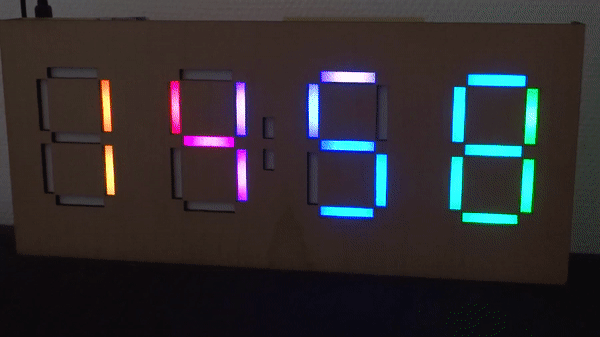When [decino]’s old bedroom clock finally bit the dust, he built himself a new one from scratch for fun and functionality.
Initially, he wanted to solder Adafruit NeoPixel lights onto four prototype boards, using a mini-USB for power and a DS1307 to keep the time. However, after soldering the board for the first digit and realizing that carrying on with the other three would be a huge pain, he switched to etching the boards instead — a far more efficient solution. In keeping with this time-saving mindset, he added a Bluetooth module that would allow him to update the clock from his phone whenever the DS1307 started dropping minutes or whenever daylight savings time is in effect.
In order to capture the light into the familiar seven-segment display, [decino] booted up his 3D printer and in short order had four shrouds for his clock that — when covered with a simple piece of paper as a diffuser — worked, well, almost perfectly. Only after enclosing the clock in its laser-cut wood case did he realize that the white filament lets some light bleed through. Luckily, a quick disassembly and some black spray paint fixed that!
As a finishing touch, and working within the strict RAM requirements of the ATtiny85, [decino] managed to eke out all the functionality he wanted. When accessed from his phone, he can change the clock’s brightness and colour to suit the day, time, whim, and up to 31 special event days. How’s that for a good-morning reminder?
If you’re too lazy to roll over and check the time from your bed, project the time onto the ceiling! Or, if waking up is your problem, you can use a Raspberry Pi and some speakers to keep yourself informed.
















But why? You’ve got an alarm clock in your phone.
Can you see it without picking up your phone, some of us with insomnia like to lnpw the time without picking up the phone
Drop any clock that is dropping minutes in a minute.
Some clocks I reluctantly set to Daniels Stupid Time, but some stay on world time year round.
Only us Indiana folk are likely to get that reference lol
Nice and very well thought project. My suggestion is to use DS3231 or GPS as RTC, that DS1307 drifts a lot, more than a minute a month, very annoying.
Yes, I also used DS3231 in my clocks and they are spot on, all around the year.
I’ve built several clocks using GPS and IRIG-B to synchronize but this clock has a lot of nice features. One of my clocks uses GPS time and also counts 60 Hz power line to display how the power line frequency drifts with power grid loading.
Nice neat build and great use of multiple technologies.
I switched to the DS3231 for a similar setup (Arduino Pro Mini, HC-06, DS3231, WS2812, Android App written in App Inventor), far more reliable time-keeping and the libraries are fairly interchangeable.
My next plan is to switch to an ESP8266, replacing 3 boards with one and saving me from having to go around setting DST.
The clock looks beautiful. I would buy one if they were for sale.
Stop calling them “NeoPixels” – that is just free advertising for a company that overcharges for the same LEDs you can buy on ebay or amazon far cheaper, WS2812 LEDs.
NTP and ws2812 driver on an esp8266…
Sketch Arduino, please!